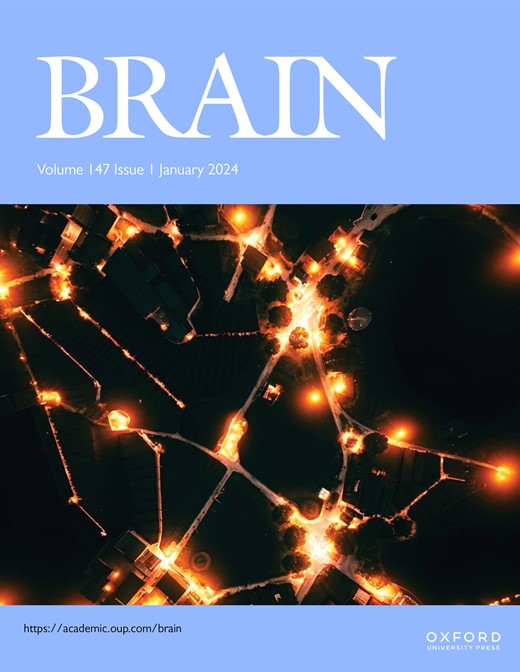FGF14重复长度和马赛克中断:脊髓小脑性共济失调的修饰因子?
IF 10.6
1区 医学
Q1 CLINICAL NEUROLOGY
引用次数: 0
摘要
深内含子FGF14重复扩增已被确定为迟发性小脑共济失调的常见遗传原因,可解释高达30%的患者。重复序列之间的中断先前已被确定影响其他重复扩增疾病的外显率。FGF14内的重复中断尚未被详细描述。我们利用远程PCR、Sanger测序、重复引物PCR、Nanopore和PacBio测序来区分fgf14相关共济失调患者和未受影响个体中存在的重复基序、马赛克和重复中断数量。之前,通过远程PCR对304例迟发性共济失调患者和190例未受影响的个体进行FGF14基因重复扩增筛查,鉴定出37例重复扩增(≥250个重复)的个体。这些和三个新发现的扩增载体被纳入本研究,并应用先进的遗传方法研究了27名患者和13名未受影响个体的重复组成。基于Nanopore数据的扩增范围从236到486个重复(SD = 60),其中20个个体显示重复中断,包括复杂的基序,如GAG, GAAGGA, gaagaaagaaggaa, gaaaagaaggaa, gaaaagaaggaa和GCAGAAGAAGAAGAA。我们从所有40个个体的长读数据中计算出最长的纯GAA长度。当比较患者和未受影响个体之间的纯GAA通道时,基于大于或小于200次重复的聚集是明显的。5例有中断的共济失调患者仍有剩余的纯GAA扩张[amp;lt;200]。我们观察到纯GAA长度与发病年龄相关(p=0.016, R2=0.256)。体源性嵌合发散性重复中断影响基序长度和序列(mDRILS),其数量和嵌合性不同(频率:0.37 ~ 0.93)。mDRILS与纯GAA长度相关(p=0.022, R2=0.334),与患者相比,未受影响个体的马赛克中断频率更高(未受影响:0.90;病人:0.67;p = 0.009)。我们证明i)需要长读测序来准确检测复杂的重复中断;ii) FGF14中的重复中断是马赛克的,在重复通道中具有不同的长度和起始位置,因此可以被注释为mDRILS,这iii)使我们能够基于剩余的纯GAA重复序列建立分类,量化mDRILS对致病性或发病年龄的影响,依赖于中断长度和位置,具有很高的准确性。最后,我们iv)提供证据表明,在中断的FGF14重复扩增中,嵌合现象稳定了纯GAA重复序列。本文章由计算机程序翻译,如有差异,请以英文原文为准。
FGF14 repeat length and mosaic interruptions: modifiers of spinocerebellar ataxia 27B?
Deep intronic FGF14 repeat expansions have been identified as a frequent genetic cause of late-onset cerebellar ataxias, explaining up to 30% of patients. Interruptions between repeats have previously been identified to impact the penetrance in other repeat expansion disorders. Repeat interruptions within FGF14 have yet to be characterized in detail. We utilized long-range PCR, Sanger sequencing, repeat-primed PCR, Nanopore, and PacBio sequencing to distinguish the repeat motifs, mosaicism, and number of repeat interruptions present in FGF14-related ataxia patients and unaffected individuals. A total of 304 patients with late-onset ataxia and 190 unaffected individuals were previously screened for repeat expansions in the FGF14 gene by long-range PCR, identifying 37 individuals with expanded repeat lengths (≥250 repeats). These, along with three newly identified expansion carriers were included in the present study, and advanced genetic methods were applied to investigate the repeat composition in 27 patients and 13 unaffected individuals. The expansions, based on Nanopore data, ranged from 236 to 486 repeats (SD = 60), with 20 individuals showing repeat interruptions, including complex motifs such as GAG, GAAGGA, GAAGAAAGAA, GAAAAGAAGAAGGAAGAAGGAA, GAAAAGAAGAAGGAA, and GCAGAAGAAGAAGAA. We calculated the longest pure GAA length from the long-read data for all 40 individuals. When comparing the pure GAA tract between patients and unaffected individuals, clusters were apparent based on greater or less than 200 repeats. Five ataxia patients with interruptions still had a remaining pure GAA expansion <200. We observed an association of the pure GAA length with age at onset (p=0.016, R2=0.256). Somatically-incurred mosaic divergent repeat interruptions were discovered that affect motif length and sequence (mDRILS), which varied in number and mosaicism (frequency: 0.37-0.93). The mDRILS correlated with pure GAA length (p=0.022, R2=0.334), with a higher mosaic frequency of interruptions in unaffected individuals compared to patients (unaffected: 0.90; patients: 0.67; p=0.009). We demonstrate that i) long-read sequencing is required to detect complex repeat interruptions accurately; ii) repeat interruptions in FGF14 are mosaic, have various lengths and start positions in the repeat tract, and can thereby be annotated as mDRILS, which iii) enabled us to establish a categorization based on remaining pure GAA repeats quantifying the impact of mDRILS on pathogenicity or age at onset, dependent on the interruption length and position, with high accuracy. Finally, we iv) provide evidence that mosaicism stabilizes pure GAA repeats in interrupted FGF14 repeat expansions.
求助全文
通过发布文献求助,成功后即可免费获取论文全文。
去求助
来源期刊

Brain
医学-临床神经学
CiteScore
20.30
自引率
4.10%
发文量
458
审稿时长
3-6 weeks
期刊介绍:
Brain, a journal focused on clinical neurology and translational neuroscience, has been publishing landmark papers since 1878. The journal aims to expand its scope by including studies that shed light on disease mechanisms and conducting innovative clinical trials for brain disorders. With a wide range of topics covered, the Editorial Board represents the international readership and diverse coverage of the journal. Accepted articles are promptly posted online, typically within a few weeks of acceptance. As of 2022, Brain holds an impressive impact factor of 14.5, according to the Journal Citation Reports.
 求助内容:
求助内容: 应助结果提醒方式:
应助结果提醒方式:


